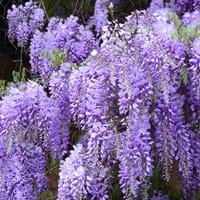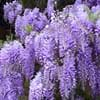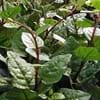Life Span
Perennial
Perennial
Type
Flowering Plants
Flowering Plants, Fruits, Trees
Origin
China, Eastern United States, Japan, Korea
Central Asia
Types
Chinese Wisteria, Japanese wisteria, Silky wisteria, American wisteria
Aceymac apple, Bailey Sweet apple, Dabinett apple, Nehou apple
Habitat
Forest edges, River side
Hillside
USDA Hardiness Zone
5-9
5-8
Sunset Zone
2a, 2b, 3a, 3b, 4, 5, 6, 7, 8, 9, 10, 11, 13, 14, 15, 16, 17, 18, 19, 20, 21, 22, 23, 24
A1, A2, A3, 8, 9, 10, 11, 12, 13, 14, 15, 16, 17, 18, 19, 20, 21, 22, 23, 24
Habit
Vine/Liana
Oval or Rounded
Flower Color
Pink, Purple, Violet
White
Flower Color Modifier
Not Available
Not Available
Fruit Color
Not Available
Green, Red
Leaf Color in Spring
Green
Dark Green
Leaf Color in Summer
Green
Green
Leaf Color in Fall
Green
Brown, Green, Light Yellow
Leaf Color in Winter
Not Available
Not Available
Plant Season
Spring
Spring
Sunlight
Full Sun
Full Sun, Partial shade
Type of Soil
Clay, Loamy, Sandy
Loamy
The pH of Soil
Neutral, Slightly Acidic, Slightly Alkaline
Neutral
Soil Drainage
Well drained
Well drained
Bloom Time
Mid Spring
Fall, Summer
Tolerances
Not Available
Drought
Where to Plant?
Ground, Pot
Ground
How to Plant?
Seedlings
Grafting, Seedlings, Transplanting
Plant Maintenance
Medium
Medium
Watering Requirements
Water in morning to avoid prompting diseases, when new, water every week
Medium
In Summer
Lots of watering
Lots of watering
In Spring
Moderate
Moderate
In Winter
Average Water
Average Water
Soil pH
Neutral, Slightly Acidic, Slightly Alkaline
Neutral
Soil Type
Clay, Loamy, Sandy
Loamy
Soil Drainage Capacity
Well drained
Well drained
Sun Exposure
Full Sun
Full Sun, Partial shade
Pruning
Cut or pinch the stems, No pruning needed in the early stages, Prune twice a year, Remove dead or diseased plant parts, Remove deadheads
Prune when plant is dormant, Remove dead or diseased plant parts
Fertilizers
All-Purpose Liquid Fertilizer
All-Purpose Liquid Fertilizer
Pests and Diseases
Aphids, Canker, Crown gall, Leaf spot, Mealybugs, Powdery mildew, Root rot, Scale
Aphids, Canker, Caterpillars, Powdery mildew, Root rot
Plant Tolerance
Drought
Drought
Flower Petal Number
Single
Single
Foliage Texture
Coarse
Medium
Foliage Sheen
Not Available
Matte
Attracts
Flying insects
Birds
Allergy
Itchiness
Mouth itching, Throat itching
Aesthetic Uses
Showy Purposes
Not Available
Beauty Benefits
Not Available
Not Available
Environmental Uses
Air purification
Air purification
Medicinal Uses
Not Available
Cancer, constipation, Diabetes, Diarrhea, Dysentry, Fever, Heart problems, Tooth ache
Part of Plant Used
Flowers, Seeds
Fruits
Other Uses
Sometimes used for making wine
Used As Food, Wood is used for making furniture
Used As Indoor Plant
No
No
Used As Outdoor Plant
Yes
Yes
Garden Design
Shady Tree, Showy Tree, Street Trees
Fruit / Fruit Tree, Shade Trees, Showy Tree
Botanical Name
Wisteria
Malus domestica
Common Name
Wisteria
Apple Tree
In Hindi
Wisteria
सेब का वृक्ष
In German
Glyzinien
Apfelbaum
In French
Glycines
Pommier
In Spanish
Glicinas
Manzano
In Portuguese
Glicínias
Macieira
In Polish
Wisteria
jabłoń
Phylum
Anthophyta
Magnoliophyta
Class
Dicotyledonae
Magnoliopsida
Clade
Not Available
Angiosperms, Eudicots, Rosids
Tribe
Millettieae
Not Available
Subfamily
Faboideae
Not Available
Number of Species
Not Available
Importance of Wisteria and Apple Tree
Want to have the most appropriate plant for your garden? You might want to know the importance of Wisteria and Apple Tree. Basically, these two plants vary in many aspects. Compare Wisteria and Apple Tree as they differ in many characteristics such as their life, care, benefits, facts, etc. Every gardener must at least have the slightest clue about the plants he wants to plant in his garden. Compare their benefits, which differ in many ways like facts and uses. The medicinal use of Wisteria is Not Available whereas of Apple Tree is Cancer, constipation, Diabetes, Diarrhea, Dysentry, Fever, Heart problems and Tooth ache. Wisteria has beauty benefits as follows: Not Available while Apple Tree has beauty benefits as follows: Not Available.
Compare Facts of Wisteria vs Apple Tree
How to choose the best garden plant for your garden depending upon its facts? Here garden plant comparison will help you to solve this query. Compare the facts of Wisteria vs Apple Tree and know which one to choose. As garden plants have benefits and other uses, allergy is also a major drawback of plants for some people. Allergic reactions of Wisteria are Itchiness whereas of Apple Tree have Mouth itching and Throat itching respectively. Having a fruit bearing plant in your garden can be a plus point of your garden. Wisteria has showy fruits and Apple Tree has showy fruits. Also Wisteria is flowering and Apple Tree is flowering. You can compare Wisteria and Apple Tree facts and facts of other plants too.





